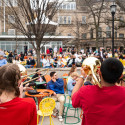Who knew?

Q. Is there really a radio station in Radio Hall?
A. No, not any more, but communication is still at its core. Actually, Radio Hall was built to house the central heating plant for most of campus back in 1887. The idea came about after the original Science Hall burned in 1884; a separate building was designed for supplying steam power to the buildings on Bascom Hill. In the 1890s, the plant was enlarged to accommodate more buildings on its system.
By 1908 a new central heating plant was erected on the south side of University Avenue and the old site needed a tenant. The mining and metallurgy department moved in and stayed until 1932, when it relocated. That was when UW’s radio station took over the building.
Renovations to support the radio station included studios, heavy insulation and an inner building suspended on springs for “vibration isolation,” according to Jim Feldman’s book, “Buildings of the University of Wisconsin.”
But there is more. The Civil Works Administration and the Work Emergency Relief Administration provided labor to create murals in the building. Considered a fine example of New Deal artwork, the designs were created by art students and professors using an American Indian theme.
“The purpose of the lobby’s design was to harmonize the ‘oldest known means of communication’ with the modern techniques of radio (and television) communication, specifically WHA Radio, which originated the Wisconsin School of the Air and many other educational programs,” according to a UW–Madison tour booklet.
Even Frank Lloyd Wright’s advice about renovating the building was sought once by Professor H.B. McCarty of the radio station. According to the tour booklet, Wright advised: “Don’t touch it, my boy; it’s one of the two honest buildings in Madison.”
WHA radio and TV moved into the new Vilas Hall in 1972, and the UW-Extension’s Instructional Communications Systems moved into Radio Hall to run interactive instructional programs. The old studios were used for teleconferencing and sending lecture broadcasts to remote areas of the state.
Just this summer, ol’ Radio Hall got a facelift in anticipation of new tenants: the digital innovation unit (aka digital TV) from WHA-TV. And so the building’s mission of public communication and broadcast carries on.
Send your question to Who Knew? c/o Wisconsin Week, 19 Bascom Hall; or e-mail: wisweek@news.wisc.edu.



